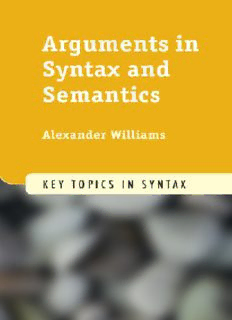Table Of ContentArgumentsinSyntaxandSemantics
Argument structure – the pattern of underlying relations
betweenapredicateanditsdependents–isatthebaseofsyn-
tactictheory,andthetheoryoftheinterfacewithsemantics.
Thiscomprehensiveguideexploresthemotivesforthematic
and event-structural decomposition, and its relation to struc-
ture in syntax. It also discusses broad patterns in the linking
ofsyntactictosemanticrelations,andincludesinsightfulcase
studiesonpassiveandresultativeconstructions.Semantically
explicit and syntactically impartial, with a careful, interrog-
ative approach, Williams clarifies notions of argument within
bothlexicalistandnonlexicalistapproaches.
Idealforstudentsandresearchersinsyntacticandsemantic
theory,thisintroductionincludes:
–A comprehensive overview of arguments in syntax and
semantics
–Discussionpointsandsuggestionsforfurtherreadingineach
chapter
–Aglossarywithhelpfuldefinitionsofkeyterms.
AlexanderWilliamsisAssistantProfessorintheDepartments
of Linguistics and Philosophy at the University of Maryland,
College Park, where he teaches semantics, syntax and philos-
ophyoflanguage.
KEY TOPICS IN SYNTAX
“KeyTopicsinSyntax”focussesonthemaintopicsofstudyinsyntax
today.Itconsistsofaccessibleyetchallengingaccountsofthemost
importantissues,conceptsandphenomenatoconsiderwhenexamining
thesyntacticstructureoflanguage.Sometopicshavebeenthesubjectof
syntacticstudyformanyyears,andarere-examinedinthisseriesinlight
ofnewdevelopmentsinthefield;othersareissuesofgrowingimportance
thathavenotsofarbeengivenasustainedtreatment.Writtenbyleading
expertsanddesignedtobridgethegapbetweentextbooksandprimary
literature,thebooksinthisseriescaneitherbeusedoncoursesand
seminars,orasone-stop,succinctguidestoaparticulartopicfor
individualstudentsandresearchers.Eachbookincludesuseful
suggestionsforfurtherreading,discussionquestionsandahelpful
glossary.
Alreadypublishedintheseries:
SyntacticIslandsbyCedricBoeckx
ClauseStructurebyEllyvanGelderen
ArgumentsinSyntaxandSemanticsbyAlexanderWilliams
Forthcomingtitles:
TheCliticbyFranciscoOrdónez
EllipsisbyKyleJohnson
SyntacticAgreementbyRobertaD’Allesandro
TheEvolutionofSyntaxbyBradyClark
StudyingSyntacticChangebyThomasMcFadden
TheSyntax–SemanticsInterfacebyTerjeLohndal
VariationinSyntaxbyJoannaNykiel
Arguments in Syntax and
Semantics
alexander williams
UniversityPrintingHouse,CambridgeCB28BS,UnitedKingdom
CambridgeUniversityPressispartoftheUniversityofCambridge.
ItfurtherstheUniversity’smissionbydisseminatingknowledgeinthepursuitof
education,learningandresearchatthehighestinternationallevelsofexcellence.
www.cambridge.org
Informationonthistitle:www.cambridge.org/9780521151726
©AlexanderWilliams2015
Thispublicationisincopyright.Subjecttostatutoryexception
andtotheprovisionsofrelevantcollectivelicensingagreements,
noreproductionofanypartmaytakeplacewithoutthewritten
permissionofCambridgeUniversityPress.
Firstpublished2015
PrintedintheUnitedKingdombyClays,StIvesplc
AcatalogrecordforthispublicationisavailablefromtheBritishLibrary
LibraryofCongressCataloginginPublicationdata
Williams,Alexander(Linguist)
Argumentsinsyntaxandsemantics/AlexanderWilliams.
pages cm.
Includesbibliographicalreferences.
ISBN978-0-521-19096-1(Hardback)–ISBN978-0-521-15172-6(Paperback)
1. Englishlanguage–Syntax. 2. Englishlanguage–Semantics. 3. Persuasion(Rhetoric)
I. Title.
PE1369.W532015
425–dc23 2014021009
ISBN978-0-521-19096-1Hardback
ISBN978-0-521-15172-6Paperback
CambridgeUniversityPresshasnoresponsibilityforthepersistenceoraccuracyof
URLsforexternalorthird-partyinternetwebsitesreferredtointhispublication,
anddoesnotguaranteethatanycontentonsuchwebsitesis,orwillremain,
accurateorappropriate.
ForMarcelandMelissa
Contents
Acknowledgments pagexi
Listofabbreviations xiii
Introduction 1
I.1 Argumentstructure 1
I.2 Ourapproach 2
I.3 Chaptersynopsis 4
PartI:Background 9
1. Syntax 11
1.1 Introduction 11
1.2 Grammarasderivation 11
1.3 SyntaxandLexicon 12
1.4 Syntacticcategory 13
1.5 Displacementinsyntax 14
1.6 Lexicalizedandnonlexicalizedsyntax 17
Discussionpoints 21
Suggestionsforfurtherreading 22
2. Semantics 23
2.1 Introduction 23
2.2 Values 23
2.3 Meanings 24
2.4 Derivation,structureanddecomposition 26
2.5 Entailmentandanalyticity 28
2.6 Indeterminacy 31
2.7 Notation 34
2.8 Semanticcombination 38
2.9 Eventsemantics 41
Discussionpoints 43
Suggestionsforfurtherreading 44
vii
viii Contents
PartII:Kindsofarguments 45
3. ArgumentsinSyntax 47
3.1 Introduction 47
3.2 Headanddependents 47
3.3 ArgumentandAdjunct 51
3.4 Lexicalistencodings 53
3.5 Nonlexicalistencodings 57
3.6 Optionalarguments 61
3.7 (cid:2)-grids 62
3.8 Externalandinternalarguments 65
3.9 Consequencesandcorrelatesofargumenthood 67
Discussionpoints 74
Suggestionsforfurtherreading 76
4. ArgumentsinSemantics 77
4.1 Introduction 77
4.2 Functionalarguments 78
4.3 Contentarguments 80
4.4 Entailedrolearguments 83
4.5 Participantarguments 84
4.6 Correspondenceofsyntaxandsemantics 89
Discussionpoints 91
Suggestionsforfurtherreading 93
5. Implicitarguments 94
5.1 Introduction 94
5.2 Implicitarguments 95
5.3 Existentialanddefiniteunrealizedroles 99
5.4 Lexicalidiosyncrasy 110
5.5 Inthescopeofquantifiers 112
5.6 Shortpassives 115
Discussionpoints 116
Suggestionsforfurtherreading 118
PartIII:Analysisofargumentrelations 119
6. Thematicrelations 121
6.1 Introduction 121
6.2 Whatarethematicrelations? 121
6.3 Motivationforthematicrelations 124
6.4 Objectionstogeneralthematicrelations 130
6.5 Kindsofthematicrelations 135
Discussionpoints 138
Suggestionsforfurtherreading 140
Description:Argument structure - the pattern of underlying relations between a predicate and its dependents - is at the base of syntactic theory and the theory of the interface with semantics. This comprehensive guide explores the motives for thematic and event-structural decomposition, and its relation to stru

